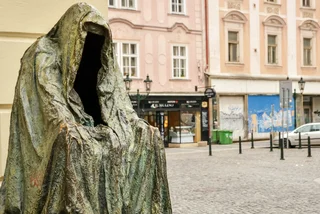With all the tourist hype over Prague´s mysterious past – the city of alchemy and magic – it´s rather surprising that the supernatural side is rarely mentioned. Other European cities, particularly those in Great Britain, offer ghostly activities galore; stories, storytelling, tours, haunted castle investigations and more. Finding any tales of Prague and of the Czech Republic can be a daunting task.
What are some of these supernatural stories?
Perchta, the White Lady
Perchta´s tale was a sad one. This 15th-century noblewoman married (actually, was forced to marry) another member of a wealthy, noble family. Her husband, Jan von Lichtenstein, was a violent, brutal man, who lived with his equally reprehensible mother and sister, all of whom tormented Perchta constantly. Perchta wrote to her brother begging him to take her away from her misery, and even King Jiří z Poděbrad acted as mediator in the troubled marriage. Eventually, Perchta was able to return to her home and family. She would never smile again. She only saw Jan once more, as he lay dying. When Perchta refused to forgive Jan for the wrongs he had done to her, he placed a curse on her.
After Perchta´s death in 1476, her ghost began to walk the estate owned by her family, the Rožmberks; in particular, she is the White Lady of the castle in Český Krumlov. If the spirit is smiling, good news will follow; if she looks serious, and wears or carries black gloves, the news will be bad.
Another White Lady haunts Krumlov, on the hill opposite the castle. This sad specter is the ghost of a young woman, who lived with her father, in a Gothic house, one of six houses that once stood on the site of what is now the Hotel Růže. When the young woman´s father refused to allow her to marry the man she loved, she threw herself from the cliff nearby. Since that time, she has appeared in the building that became the hotel, and continues to visit it even now. Startled guests have sometimes asked the hotel reception, “Who was that woman in our room last night?”
The 27 noblemen
In the year 1621, 27 noblemen were executed on Prague´s Old Town Square for their part in the Battle of Bíla Hora. The executions, which took four hours, were performed by executioner Jan Mydlář. Three of the men were hanged; the rest were beheaded. One of them, Jan Jesenský, had his tongue cut out before the beheading. After his execution, his body was cut into quarters and placed on the road leading to Kutná hora except for his head.
The heads of twelve of the noblemen, including Jesenský (with his tongue nailed to the side of it) were dumped into iron baskets and placed on the Charles Bridge. One man´s family succeeded in having his head returned to them the following year; the others remained on the bridge to rot. Legend has it that the skulls now occupy space beneath the floor of Týn Cathedral.
The noblemen haunt the bridge, calling to passersby late at night; in addition, they rise from their graves in the Church of the Holy Savior once a year to view the Astrological Clock on the Old Town Hall, to ensure that all is well.
Speaking of heads, Malá Strana is haunted by the ghost of a young woman named Laura. Although married, Laura became enamored of a count who was equally fond of her. Laura´s jealous, violent husband discovered this emotional affair, and sent the count a box containing Laura´s head. Her ghost, still searching for the head, haunts the Dominican Monastery.
Kutná hora, famous for its church decorated with human bones, also has its ghosts. A miser named Ruthard was so tight with money that he couldn´t bear the thought of parting with any of it to provide a dowry for his daughter, Rosina. One day, he led her into a room filled with money, then shouted, “Here´s your dowry, you slut!” – and walled up the room, with Rosina inside. Rosina starved to death, and since that time, has appeared when any calamity is to befall the house.
A Knight Templar rides Liliova Street at midnight, carrying his head in the crook of one arm. His ghost can only rest if someone has the courage – and the strength – to seize his horse´s bridle, take the knight´s sword and run it through the ghost´s heart.
Celetná Street witnesses the re-enactment of an infamous event. One evening, as a priest walked down the street, one of the local prostitutes decided to play a joke by flashing him. The enraged priest struck the prostitute with his crucifix, killing her instantly. When he realized that she was dead, he himself died on the spot. The witching hour of midnight is the time to see these two acting out the final events of both their lives.
Týnský dvůr is haunted by the ghost of a Turk who became engaged to a young Czech woman, then returned to his homeland to ask his parents‘permission to marry her. The Turk was gone for a long time, and his fiancée, hearing nothing of him, began to believe that he had died, or that he had forgotten her. The Turk returned to Prague only to find that the young woman had just been married, and was celebrating with her family. She disappeared that night, and was found some time later, decapitated. The courtyard is haunted by the Turk, who offers passersby a glimpse into the box he holds – which contains the young woman´s head.
One final legend has it that every Friday at midnight, Janský vršek Street offers the spectacle of a black coach drawn by black horses. The occupant of the coach is a headless skeleton in flames. Supposedly, after an hour´s drive along this short street, the coach and its occupant sink into the ground.
Halloween isn´t yet a popular holiday in the Czech Republic, but it seems to be gaining ground. Certainly, the ghostly history here is a respectable one, worthy of telling and retelling.
Photos by Erin Naillon












 Reading time: 5 minutes
Reading time: 5 minutes 
























